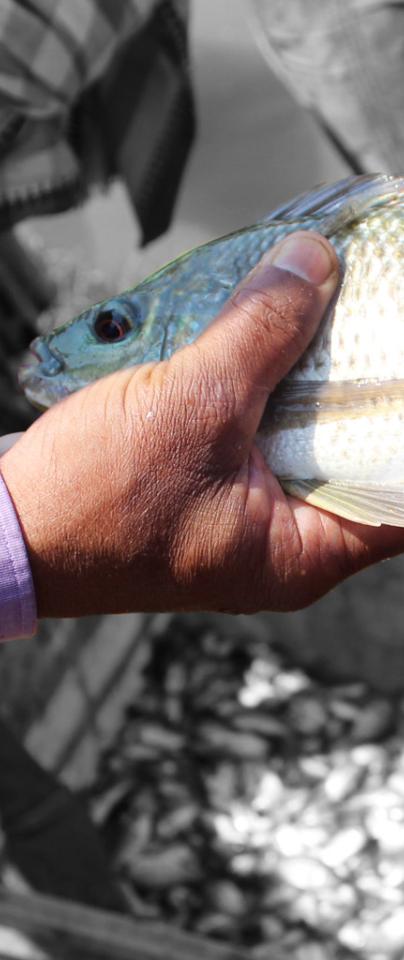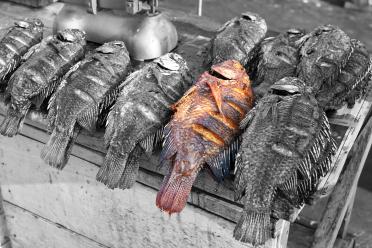The fishy escapists
Revealing tilapia’s hidden hybrids to boost aquaculture and biodiversity

Freshwater fish farms are an increasingly important resource. But when farmed fish escape and interbreed with their wild relatives, aquaculture and biodiversity suffer. What can genomics do about it?
Farmed fish - tilapia in particular - has become a critical food source, especially for those living near the rambling rivers and sprawling lakes of East Africa’s Great Rift Valley. While offering a mouthwatering prospect for farmers and consumers alike, these vast and diverse bodies of water are also teeming with biodiversity - the crown jewels of which are the thousands of species of cichlid fish that popularly dazzle aquariums the world over.
Tilapia also happens to be a species of cichlid, which spells trouble when it pulls off the aquatic equivalent of a prison break.
“Escape is a real issue”, says Dr Antonia Ford. “From the aquaculture perspective and in terms of biodiversity threats to wild fish.
“Farms are often earthen ponds dug out from the soil, so if there's any flooding or heavy rain, it's quite easy for those fish that have been imported to be accidentally introduced into wild water bodies.”
Connected by criss-crossing networks of tributaries, rivers, and lakes, those water bodies are home to many native tilapia species, some of them unique to the region. Alas, according to genomics research carried out by Ford (soon to join DEFRA), Tabitha Blackwell of the University of Bristol, and Dr Adam Ciezarek from the Earlham Institute, there are signs that interbreeding between farmed and native fish is rife.
“There are quite large parts of the genome where we can see that native fish and escaped Nile tilapia are the most closely related to each other,” says Ciezarek, who used the Earlham Institute’s supercomputers to compare the genomes of two populations of native O. korogwe fish with that of the Nile tilapia.
“These are quite long bits of DNA we’re finding. In one chromosome, a whole half of it seems to have been integrated from tilapia into the native population - and our analysis suggests it’s the result of fairly recent gene flow between them.”

That interbreeding puts biodiversity under severe strain. Wild fish, which had been perfectly-adapted to the local environment, can begin to struggle as genes that were selected for over many generations are lost in the genetic whirlpool.
“There are 13 species of tilapia that only occur in Tanzania, and a lot of them only occur in one water body,” says Ford. “We've seen lots of cases where fish lose that genetic adaptation to the local environment, because of the disruption of those gene complexes.”
Alarmingly, the native population of O. korogwe that Ford and Ciezarek studied had only recently been discovered - a bittersweet finding this study would confirm.
“When most people think of discovering a new species, they perhaps think it's something that no one's ever seen before,” explains Ford. “This is something that's been in plain sight, and people knew about it. But what we didn't know was that it was unique.
“There's still a lot of work we need to do to find those populations. And yet, by the time we get there, it might be too late. They might already be hybridising with other species and no longer unique.”


That interbreeding puts biodiversity under severe strain. Wild fish, which had been perfectly-adapted to the local environment, can begin to struggle as the advantageous genes that were selected for over multiple generations start to get lost in the genetic whirlpool.

In a double-whammy, what poses a threat to biodiversity also threatens the productivity of tilapia farms.
“In Tanzania, what we’ve seen is that a lot of suppliers have gone and harvested wild strains of tilapia that haven't been genetically improved, and just harvested them from Lake Victoria,” says Ford.
“When they’re caught at a very young stage - when they're very small - they look very similar to any other species. What we found in one of the government hatcheries was that the strain that was being sold was actually a hybrid strain.”
Hybrid strains are bad news for aquaculture. The predominant fish used in aquaculture worldwide is a genetically improved fish that has been specifically bred to grow faster - and it’s important for farmers that they’re getting the right fish into their ponds.
“Hybrid fish often do less well in their environment,” explains Ford. “They tend to have reduced growth, and they don’t yield as much. We often see stunting. In pond systems where a farmer has introduced - often accidentally - a hybrid mix into their pond, within generations they're not economically viable to farm anymore.”

Though the outlook for local biodiversity seems dire, what DNA can tell us about hybrids in one population can help us spot them anywhere. Much like how we can test a population of people for a virus like COVID, it should - with the right tools being developed by Ciezarek and Ford - be possible to detect hybrid fish.
“Another piece of work we're doing is trying to get a small set of SNPs, identifiable changes in DNA, that we can use to identify missing hybrids,” says Ciezarek. “It’s a diagnostic tool to spot a hybrid fish that will test whether we can find evidence of the Nile tilapia genome in any of the fish we find.”
The technique can hopefully be applied in aquaculture systems to help farmers understand exactly what they’re raising, without needing the expertise required to spot the morphological differences between fish.
“For farmers, introducing hybrids into ponds obviously has issues,” says Ford. “That's part of why we wanted to develop this SNP panel, which is an easy way of being able to genotype the fish and quickly assess whether they're likely to be the real thing.”


Hybrid strains are bad news for aquaculture. The predominant fish used in aquaculture worldwide is a genetically improved fish that has been specifically bred to grow faster - and it’s important for farmers that they’re getting the right fish into their ponds.

If this diagnostic technique proves feasible on the ground in East Africa, the researchers hope to redress the balance for native and farmed tilapia alike. The next step is to get genetic information for as many fish as possible, which helps to form a region-wide map of hybridisation.
To that end, the team is set later this year to publish the outcomes of a GCRF Data and Resources and UKRI-BBSRC-funded analysis of around 600 tilapia individuals.
“We want to assess the level of gene flow, especially identifying invasive species, or even identifying species that are of economic value in terms of farming - helping to identify stocks that can be used by breeders,” says Dr Wilfried Haerty, Evolutionary Genomics Group Leader at the Earlham Institute.
“Through analysing the population structure based on river basins, we can already say there is strong evidence of both ancestral and ongoing gene flow. Ultimately, we hope to use this information to help guide policy and farming practices in the region.”
If all goes well, hopefully down the line these diagnostic tools will secure the fate of those fish populations still unperturbed by hybridisation - and that barbequed tilapia will taste all the sweeter for it.
The research described in the main body of this article was equally contributed to by Tabitha Blackwell (University of Bristol), Adam Ciezarek (Earlham Institute) and Antonia Ford (University of Roehampton), involving the research groups of Martin Genner (University of Bristol), George Turner (University of Bangor), Federica Di Palma (University of East Anglia) and Wilfried Haerty (Earlham Institute).